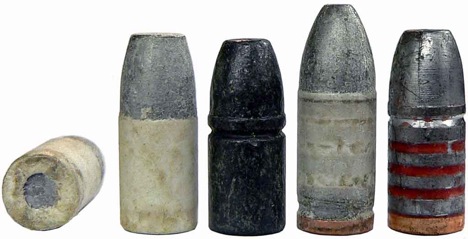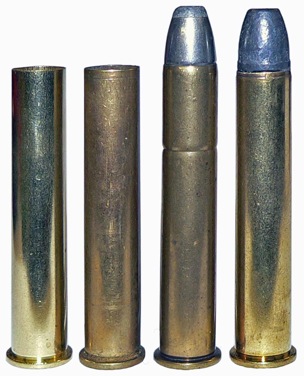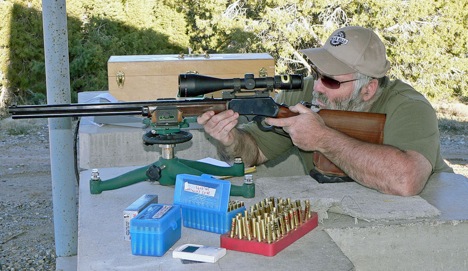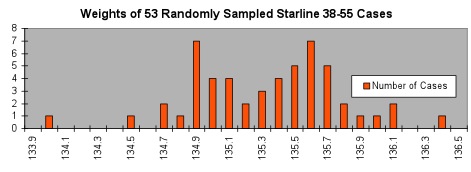Synopsis: The 38-55 Winchester Center Fire (WCF) is a unique example among metallic cartridges — through almost 125 years of production, until quite recently, 38-55 cases had evidently never been made correctly for use with conventional bullets. Starline recently solved that problem. For most shooters loading conventional cast bullets in guns with standard 38-55 rifle bores and correctly cut chambers, using the 2.125-inch long, thin-necked, Starline 38-55 Winchester cases can provide a significant accuracy improvement.
In 1879, Ballard introduced the 38-50, which featured a 2-inch-long case (many tapered cases of that era were named not for capacity but for length and for that reason many were made to specific lengths based upon inches and fractions of one inch — usually, in half- quarter- or eighth-inch increments). But, this convention was often supplemented by listing the charge used, rather than the case length. For example, the Sharps Rifle Company listed the chambering as 50-2½" Sharps but marketed the ammunition as 50-90 Sharps. (Cartridge naming has always been confused and confusing, it seems.)
Ballard evidently viewed the 38-50 rifle chambering strictly as a target-shooting combination. For this reason, it sized the chamber to take best advantage of cartridges loaded with paper-patched bullets. In that era, paper-patched bullets were the most accurate design known for cartridge loading.
When used in front of a black powder charge, paper-patched bullets work best when designed significantly smaller than groove diameter. With such loads, when the charge ignites, the relatively rapid increase in chamber pressure accelerates the bullet so fast that the core begins to swell (obturate) before the bullet moves significantly. Thereafter, obturation rigidly bonds patch and core, centers the bullet well within the rifling, and prevents significant gas blow-by.
Most critical to this discussion, as experience had shown, if the bullet was initially sized too large, obturation could not swell the bullet sufficiently to adequately bond the core to the patch and accuracy would be lousy. It is also unlikely that such a bullet would rapidly and symmetrically shed the paper jacket after exiting the muzzle (because the paper would not be adequately stretched and weakened by bullet obturation); this too would hamper accuracy.
In every black powder-era chamber that I have seen that was designed for use with cartridges using paper-patched bullets, it seems that the design goal was to hold the paper-patched bullet centered in a case neck that fit the chamber without much expansion and then to allow the bullet to expand into the chamber throat as it exited the case mouth, so that, as it entered into the rifling, it was already well centered within with the bore and the patch was well stretched. Whatever the logic might have been, it worked and these guns and loads were phenomenally accurate. In many of these guns, it is simply not possible to use bullets of groove diameter in cases with normal neck thickness.
This situation was not confined to the 35-55 rifle; rather, the 38-55 is the only one of those early chamberings that survived, unaltered, into the modern era. Moreover, In our ancestors’ days, those who wanted to use conventional cast bullets to target shoot with such guns preseated a groove diameter bullet into the chamber leade ahead of a case charged with blackpowder and sealed with a card wad, because they knew that a groove-fitting bullet would not work in the case and that therefore separate bullet seating was necessary to use a conventional bullet that was sized to give good accuracy.
In 1884, Winchester modified the 38-50 Ballard case by increasing the length to 2?-inches. It thereby introduced a hunting cartridge under the moniker 38-55 Winchester Center Fire (WCF). Evidently, Winchester made no effort to modify either the chamber or cases, to allow for use of conventional cast bullets sized for best accuracy. While the experts at Winchester might have known that, for best accuracy, conventional, grooved-and-lubricated, cast bullets should be slightly larger than barrel groove diameter, any accuracy difference with the soft bullets used with black powder was evidently not enough of a concern to warrant a change in chamber or case design.
In that era, with black powder as the only propellant and with the relatively soft bullets that worked best with black powder, this situation caused little problem. Folks who were concerned with maximum accuracy would be most apt to use paper-patched bullets, so any modest accuracy loss associated with the necessity of using “too-small” conventional cast (or swaged) bullets simply did not matter to shooters and, if it did not matter to shooters, it did not matter to Winchester.
The curious thing is that through subsequent generations, until about 100 years after manufacturers began offering smokeless 38-55 loadings and more than 90 years after factory black powder loads were no longer routinely offered, no case manufacturer ever addressed the fact that with the, necessarily harder, cast and jacketed bullets used with smokeless loads, it was impossible to use a bullet that was sized correctly for the bore and groove sizes of 38-55 rifles made with chamber and bore dimensions according to standard specifications.
While I have been unable to locate examples of true balloon-head 38-55 cases (I am not even certain that such 38-55 cases ever existed), I do have several semi-balloon-head 38-55 examples, likely dating from before the turn of the last century. Neck thickness on those, while somewhat thinner than modern (standard) 38-55 cases, is nonetheless too thick to allow use of groove-diameter cast bullets. I cannot prove that none of the earliest 38-55 cases had such “thin-enough” necks, but I have seen nothing to suggest that any such cases ever existed. The fact that standard 38-55 bullet diameter has always been listed as 0.377- to 0.378-inch, while groove diameter has always been listed as near 0.379-inch lends strong support to this view.

Sample bullets sized correctly to work in 38-55 Starline cases and standard 38-55 rifle chambers and barrels, left to right: conventional paper patch, 252-grain, 0.381-inch (showing base and side views); Bear Creek Supply, 255-grain with baked-on, moly saturated, resin, 0.3815-inch; Wosika “Label-Patch,” 281-grain, 0.3795-inch, gas checked; Mount Baldy, 280-grain, 0.379-inch. (Listed diameters and weights are approximate nominal.)
So, evidently, this situation continued through the ages. For example, several years ago when Marlin and Browning briefly offered 38-55 chambered guns, both used “correct” chambering and rifling dimensions, as specified both by history and by the Sporting Arms and Ammunition Manufacturers’ Institute (SAAMI). Many serious shooters who bought those guns discovered that seating conventional cast bullets that were sized to ideal diameter for best accuracy (groove diameter or 1/1000-inch larger than groove diameter) in standard cases created loads that would not chamber in those guns. Testing proved that in those and other guns with conventional chambers, using conventional cases necessitated the use of bullets sized at least one-thousandths-inch smaller than groove diameter, else the round would not chamber. (In many gun and case combinations, the bullet had to be two or more thousandths-inch smaller than groove diameter, else the loaded round would not chamber.)
Subsequently, many of those folks loudly decried these manufacturers for “making the chamber wrong!” Unfortunately, in order to be able to use “correctly” sized bullets, many of them altered the gun chamber.
After The American Rifleman and Precision Shooting published articles that I wrote covering these guns, I soon heard from several such shooters. I got calls from three such shooters, who reported their experience and that of three other shooters. Each reported that this chamber alteration had ruined the accuracy of what had been a fine gun. Subsequently, I have heard from several others who have tried this approach, no one has ever told me that they gained anything through this approach — again, most reported having seen a significant accuracy loss — despite using correct-diameter bullets in the altered chamber and despite almost endless load development.
I cannot explain why it seems to be impossible to recut the chamber neck larger without fouling the accuracy of these guns, I can only report that this is what seems to happen, regardless of who does the work, regardless of who designs the chamber-modification reamer, regardless of who makes the reamer, and regardless of what kind of loads, loading techniques, and loading dies the shooter uses.
![]()
Mounting a Trijicon scope in Talbot rings and Base assembly on Marlin Cowboy 38-55 rifle. Getting ready for serious accuracy and load development testing, with bullets that properly fit the bore — first time ever with this rifle, made possible only through release of Starline cases with proper length and neck thickness.
Despite this, folks keep doing this and I have long-since grown weary of trying to persuade them against doing what has been repeatedly proven to be a mistake — I cannot guess how many folks have spent time and money only to end up with a gun that will never shoot as accurately as it originally did, despite my best explanation and fervent warning: “Nothing is wrong with the chamber; the problem is: The case necks are too thick. Altering the chamber is most apt to result in an accuracy loss — leave the chamber alone!” Therefore, a word to the wise, before buying a used one of these guns, a prudent person should insist upon seeing a chamber cast, to verify that no one has altered the chamber.
Dave Manson — Manson Precision Reamers — now sells a 38-55 rifle chambering reamer built to my specifications. This design takes advantage of modern chamber-design theory and the resulting chamber works correctly with new Star-Line cases discussed in this piece. Most serious target shooters using the 38-55 rifle have found that this reamer cuts a chamber that provides significantly superior accuracy with any tested conventional-cast bullet of groove diameter or slightly larger and with jacketed bullets of groove diameter and it has become a bestseller for Manson. This reamer will not “fix” an existing chamber; it is necessary to set a chambered barrel back far enough so that this reamer cuts out the entire existing chamber, throat, and leade.
The second problem with modern standard 38-55 cases stems from the “economy of production” approach that manufacturers adopted after World-War-Two, when reintroducing ammunition for this chambering. Prior to that, manufactures usually made 38-55 cases at correct length, near 2.125-inches (however, I have found many, shorter, exceptions to this in very old cases).
Previously, when manufactures head stamped this same basic case for the necked-down versions (30-30, et al), it was necessary to trim the resulting case significantly, to get the length right (nominally, 2.05-inches, maximum). The modern alternative of selling a shorter version of the parent case allowed use of less material and reduced production time (less drawing and subsequent trimming, etc.). Because the 38-55 was a modest seller, compared to the 30-30 and other cases that had been derived from the 38-55, this approach made good economic sense. But, one does wonder why Winchester found it worthwhile to shorten the necked-down 38-55 case when it created the 30-30, because it could have simply left the case full length and moved the cannelure about 1/16-inch farther forward on the bullet — another mystery lost in history.
I suspect that the Winchester technicians made the original 30-30 cases by necking-down and fireforming 32-40 cases, which shortened during fireforming. So, without thinking the decision through, someone settled on a case length slightly shorter than the shortest fireformed 32-40 test case and made chambering reamers for the guns before discovering that necking the parent case body directly to 30-30 resulted in a longer case. Then someone decided that trimming “a few” cases would be less expensive that making new reamers (no one involved could possibly have predicted that the 30-30 would soon be one of the largest selling centerfire rifle cartridges of all time, a reality that soon rendered “a few cases” into “a whole bunch” of cases.
The fact that this post-World-War-Two economy-based decision resulted in factory 38-55 rifle cases that were far too short was of no significant consequence. Shooters were thrilled to have anything to shoot in their 38-55s and — as noted above — accuracy was never much of an consideration to the ammunition manufacturer anyway and few shooters realized that accuracy was less than it could have been. So, despite the fact that the chamber was always designed for 2.125-inch long cases, standard length for post World-War-Two cases was 2.08-inches (again, I have found examples that are significantly shorter). What did not matter to consumers did not matter to manufacturers.

Left to Right: New Starline, correct length and neck thickness; Redrawn W-W, correct length but neck too thick for use with bullets of proper diameter; pre World-War-Two factory load, case correct length but neck too thick and bullet too small to properly fit bore; modern factory case, too short, neck too thick, and bullet undersized.
After considerable prompting from many serious handloaders, including me (some might even say that I led that charge). Starline took the not insignificant plunge toward solving these problems. It created correct-length (2.125-inch) 38-55 cases with thin enough necks to allow use of correct-diameter cast bullets in any standard chamber. This allows handloaders to finally bring this circa-1884 chambering into the modern world with what are the first correctly made loads — loads using conventional cast (or jacketed) bullets that are actually sized correctly for best accuracy. It remains for us to persuade bullet and mould manufacturers to offer what we need to fulfill this potential — 0.379-inch jacketed bullets and cast bullets that will size to 0.380-inch.
I am thrilled that Starline made this leap of faith and I am pleased to report that Starline has been selling enough of these fine cases to justify the associated cost and effort. As 38-55 rifle owners who have not already ruined the fine gun (by butchering the chamber) discover the advantages of Starline 38-55 cases, I expect that sales will continue indefinitely.

Starline case, correct length and thin enough neck to allow use of bullets of ideal diameter for standard 38-55 rifle bores.
Those familiar with my writings well understand that I am hard to please and that I am not particularly shy. So, I will report here the single complaint I have with what Starline did.
Starline failed to introduce this new and otherwise ideal case with the “correct,” primer pocket, one sized correctly to use small-diameter primers. This is no surprise because Starline had to consider customer perceptions and expectations; nevertheless, this is entirely too bad. Folks expect 38-55 family cases to use large-rifle primers, despite the fact that the earliest 38-55 cases had small primer pockets and worked perfectly well and the fact that such cases with a small primer pocket would have every advantage for any feasible modern load used in any of these cases.
With modern primers (since about 1950), large primers are strictly unnecessary in this family of cartridges. Small-rifle primers provide more than enough ignition energy and would allow handloaders and factory producers alike to choose relatively milder primers that would give superior ballistic uniformity with most loads. As a bonus, cartridges with small-diameter primers are vastly less sensitive to potential ignition due to recoil in a tubular magazine and would therefore allow use of bullets with significantly smaller meplats, thereby significantly improving exterior ballistics, without sacrificing safety. To make my point crystal clear: In cases of this basic family, the large-rifle primer pocket has no advantages and it has many disadvantages; it is, frankly, a mistake.
Today, this change would cause some logistic troubles but if this change had occurred when this family of cases was reintroduced after World-War-Two, those problems would have been truly modest and all who shoot 38-55 family cartridges would be better off today.
I took various measurements on 53 new Starline cases from the first production run. These measure essentially identical in length, at 2.125-inch. As with all bulk-packed cases, I recommend neck expanding, bell mouthing, and inside deburring before first use — no fault of Starline, these relatively thin necks are easily dented during shipping and handling.
The headstamp includes what I consider to be a useful addition, “2.125,” which some folks decry but I certainly appreciate. These (correct) 38-55 cases are thereby headstamped distinctly from all other (incorrect) 38-55 cases ever made.
As presented in the associated table, analysis of weights for this sample suggests that either something changed during production or that these cases do not well represent a random sample from this production run — weight distribution of sampled cases has two distinct peaks, which is at least odd (with a random sample of 53, it is extremely unlikely that this was a statistical fluke). Regardless, overall weight uniformity is certainly adequate. Total weight variation of 51 of these 53 cases is 1.4 grains (134.5 to 136.1 grains), which represents exceptional uniformity.
I would call the single lightest and heaviest cases significant outliers. I would sort out such cases and use those only for gauging. After such sorting, more than 95% of these cases would weigh from about 134.5 to about 136.1 grains. Generally, such a variation in case weight would result in only about 6-fps maximum velocity variation with otherwise identical loads.

A Marlin is never easy to shoot from the bench. Adding a scope with a large objective bell just makes matters worse — note complete lack of cheek weld. Nevertheless, I have shot dozens of sub-MOA, 100-yard groups using this gun. I once shot 20 of the Bear Creek Supply load into one ragged hole at 100 yards — that group measured under 1¼-inch on centers.
Generally, while difficult to shoot well from the bench, Marlin rifles are capable of far better accuracy than many shooters realize. My 38-55 rifle is no exception. The high quality barrel on my cowboy Marlin has long-since proven exceptionally accurate when shooting relatively soft Bear Creek Supply bullets (with a baked-on “jacket” made of resin that is saturated with molybdenum-disulfide), even when it was necessary to use too-small bullets loaded in too-thick cases (redrawn by Buffalo Arms to correct length). (On many of its Cowboy guns, Marlin chose to contract with a well-known custom barrel maker and the resulting octagonal barrels are generally extremely accurate.)
I am certain that these cases and correct-diameter bullets will prove even more accurate. Time at the range will tell that tale.

DISCLAIMER: All reloading data in this article is for informational purposes only. Starline Brass and the author accept no responsibility for use of the data in this article.
This article, including pictures and captions, first published in Precision Shooting magazine (now defunct). This material is the property of the author. We have used it here with his explicit permission.
